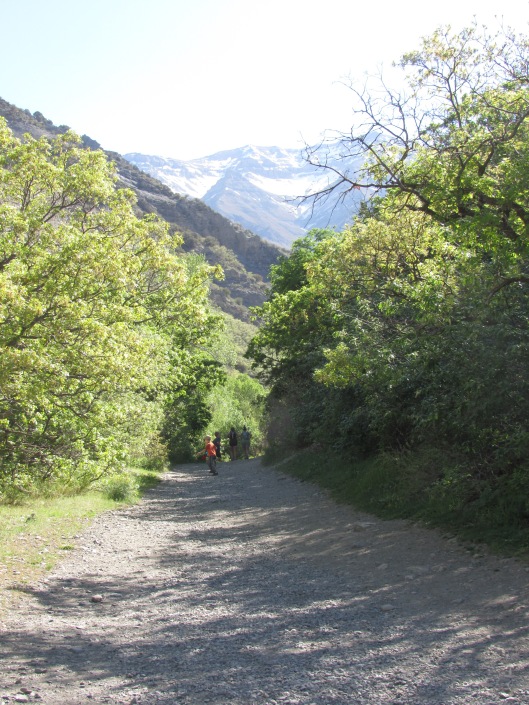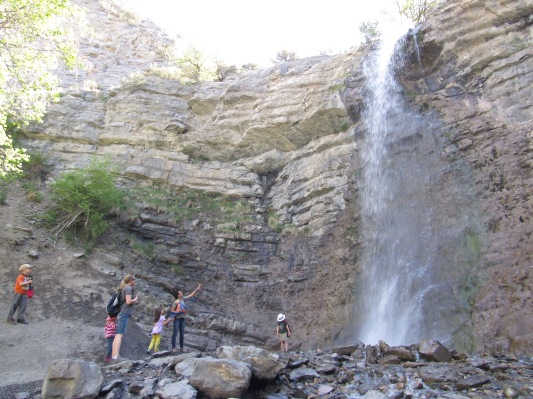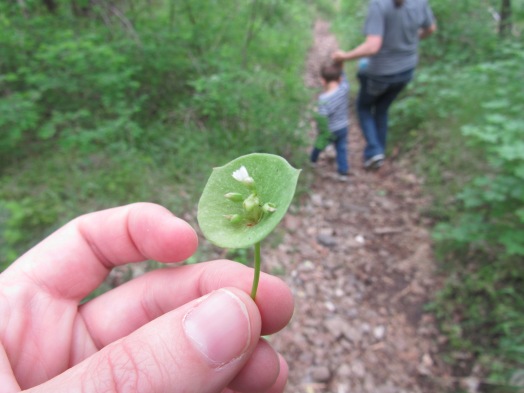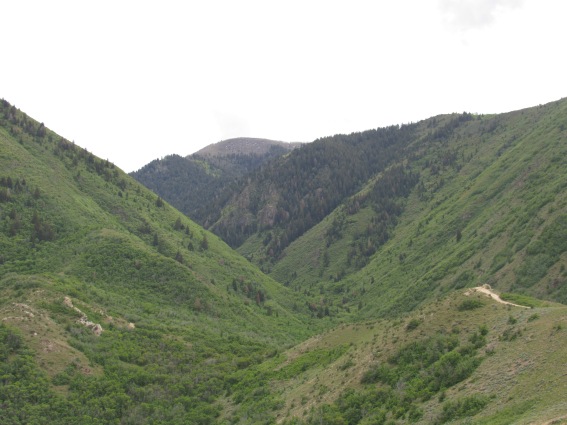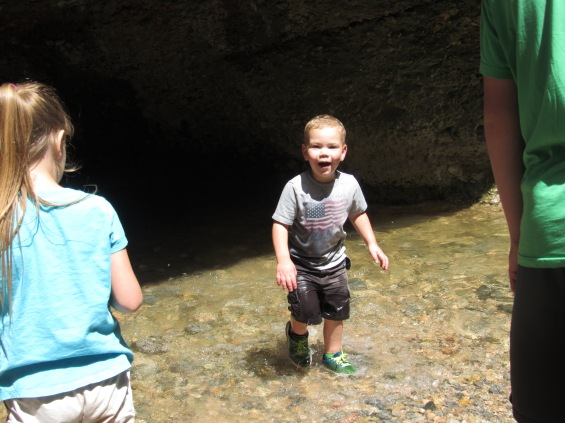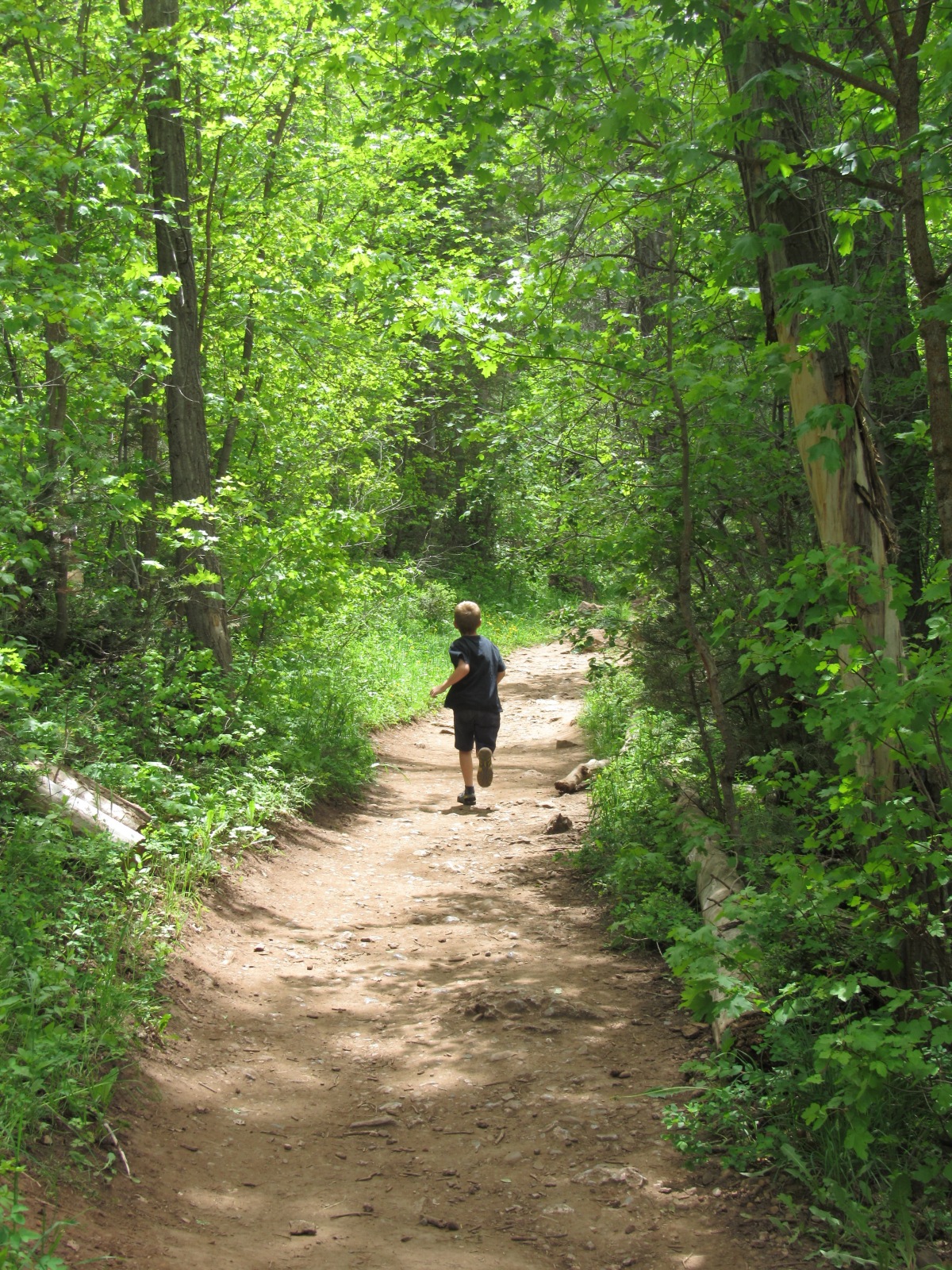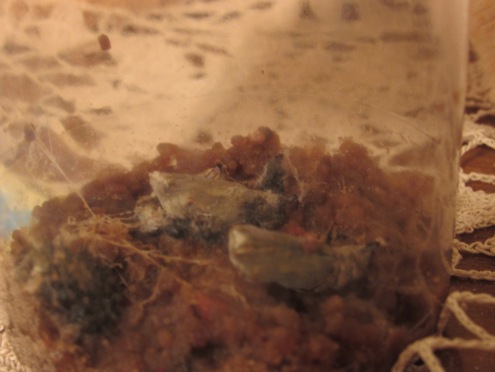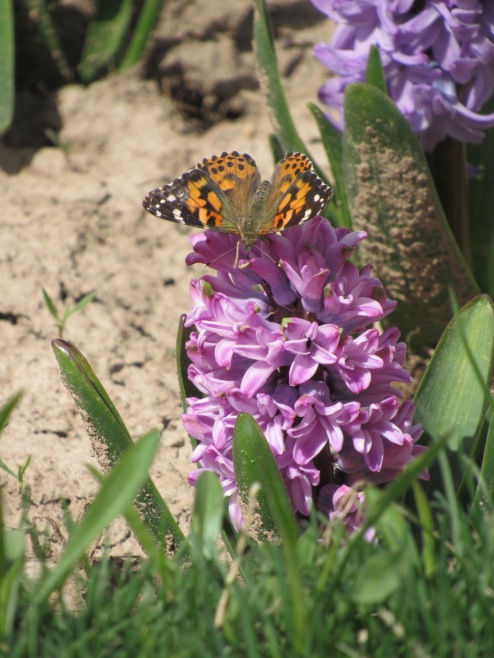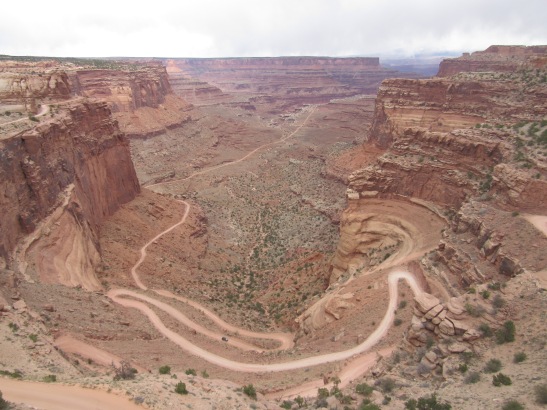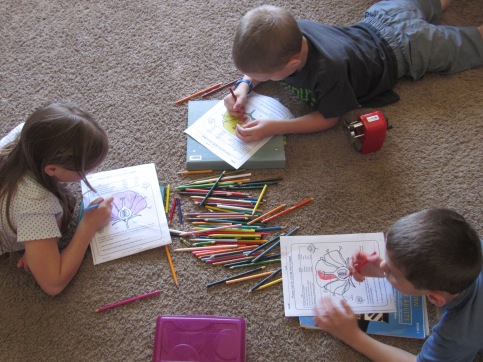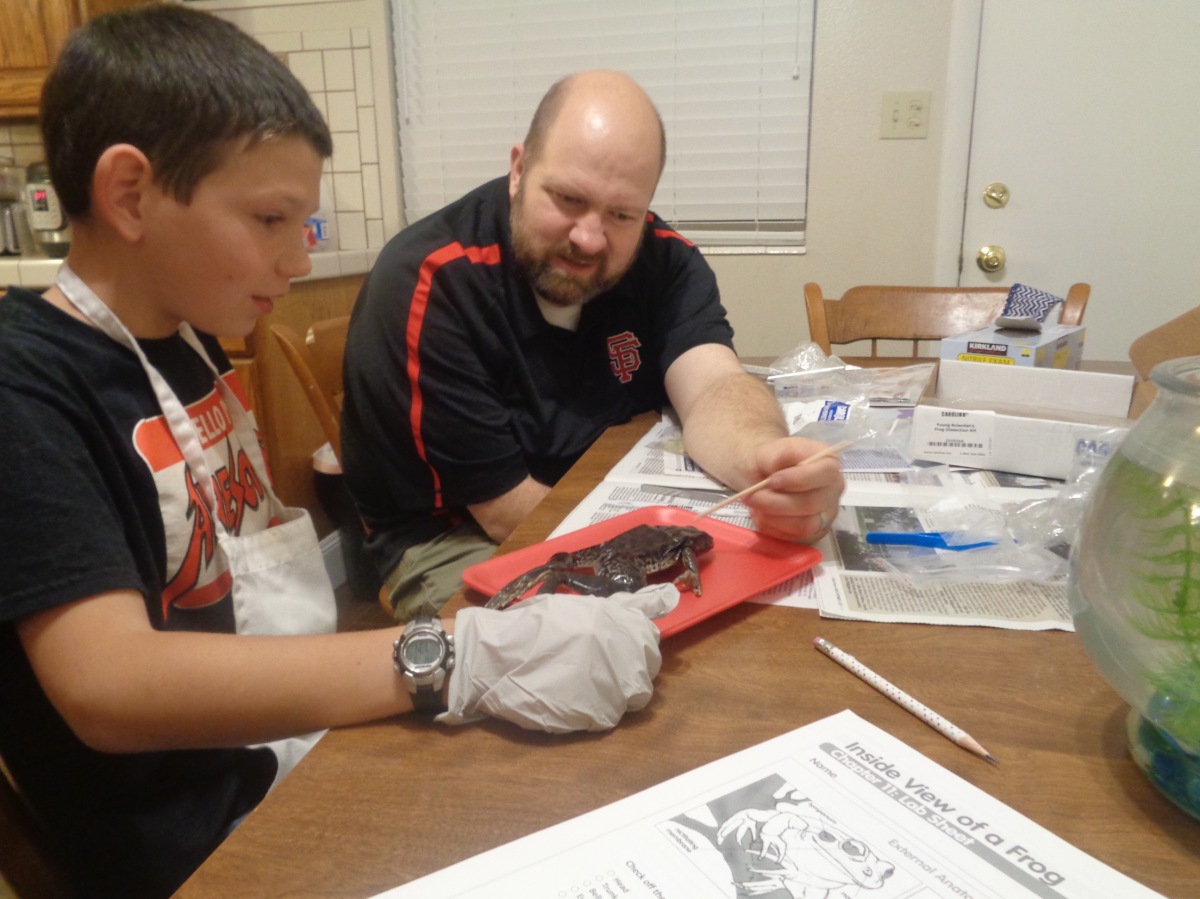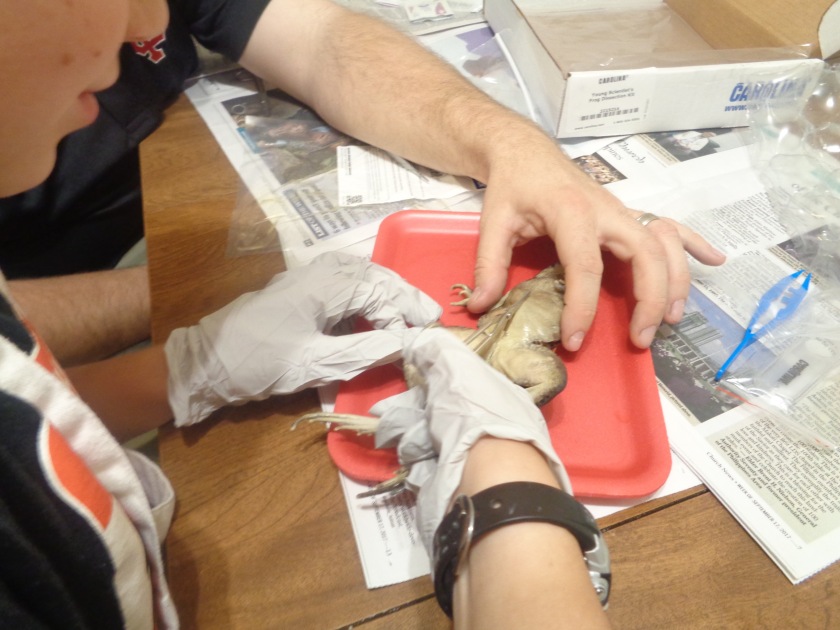There were some really good things and then again, there are some things to work on. But isn’t that how it usually is? Well, sometimes there are some pretty crappy things, but overall school was pretty good. No, it was better than just “pretty good.” It was something to be proud of.
(Or “of which to be proud,” if the end of sentence preposition bugs you – it bugs me sometimes.)
Having three kids in homeschool for the first time can maybe be likened to having your third child. Technically, unless your husband was home, you were outnumbered with the second, but the third just makes it painfully obvious in case you were in denial before. Multiplying your children also multiplies your work load, whether you homeschool or not.
But definitely when you homeschool.
So I told myself over and over again that it was ok to be stressed out sometimes. It was ok to be frustrated and feel overworked. It was ok to somedays be so aggravated that I wanted to put that third child in public school and not have to deal with all of his push back and defiance anymore.
(There! See? Now I’ve had that experience, too! It didn’t last terribly long because I can’t imagine ever sending my children to public school, but still. Now I understand what I’ve only heard other people say before. More than once, I did in fact tell myself all of these troubles would be gone if I just sent that kid away to school. Of course, then we would just have a new set of troubles to deal with…)
Let’s start with what went right and some of the details.
My older two, the 5th and 3rd graders, learned how to work independently on most of their school work! I give myself major points for this victory, although I’m sure I had absolutely nothing to do with it. My 5th grader just hit that developmental milestone and suddenly internalized responsibility (somewhat, at least) and like magic, now he can teach himself math, grammar, handwriting, and how to write essays! And simultaneously my 3rd grader did all that, too. She’s a girl, so I hear that may have something to do with it. Whatever and however, one truth remains.
It. Was. Awesome.
Fifth Grade Review
The 5th grader completed Saxon Math 7/6, Writing and Rhetoric books 3 and 4 (Narrative II and Chreia and Proverb), The Good and The Beautiful Language Arts Level 4, Zaner-Bloser Handwriting Level 5, Latin for Children Primer C, and RSO Biology Level 2. You can read about our entrepreneurship fun at the link included there. He also took private piano lessons for music. For history, he followed along with the little kids in their Story of the World Volume 1: Ancient Times.
Math was awesome. Wouldn’t change a thing. Writing and Rhetoric, also awesome. The Good and The Beautiful for grammar? I know it’s the new cool thing to do. And it is both good and beautiful. But it wasn’t what I was looking for. There was too much overlap and redundancy (not the good kind) with the Writing and Rhetoric program and there was less grammar than what I had hoped. It is an beautiful Language Arts program – but I didn’t really want a Language Arts program, I wanted a grammar program. So we won’t be using it again – at least not with this particular child. The handwriting book was kind of meh. But not meh enough in a bad way to ditch it. His cursive is pretty nice, but his manuscript writing is still, well, not as nice. I’m just going to stick with that one.
Latin was hard! I read on CAP’s website that students who finish LFC Primer’s A-C can jump right in to Latin Alive 2, but my son and I both feel better doing Latin Alive 1 next year to help solidify some of this stuff.
That third declension! Why? Just why?
And I think the adverbs would have been a little easier if they didn’t all look and sound so similar, or if they didn’t translate to words like “whence,” “thence,” “whither, and “thither.” It’s like translating a dead language into another dead language and then into English.
Biology was really awesome. But it would have been more awesome if I only had one child and could focus all my time on that. It was too much for me. We now have a really cool microscope all nicely stored back in it’s box, because doing all those labs just got to be too much. More than half the time we couldn’t even get them to turn out right. I never, ever did see any bacteria in our yoghurt, nor half the other things we were supposed to see. But we certainly tried and we certainly learned a great deal. We didn’t have time to do any of the famous science research assignments. But I guess maybe that is what makes this program so good? There are so many options of things to do and ways to learn all of them, you get to pick and choose which ones you want to/have time to do? (Am I stretching too much?) That is how I had to look at it in the end anyway. We just had to pick an choose – and we chose to read the lessons, do the “Show What You Know” quizzes at the end of each chapter, review everything, and then take the end of unit tests.
History was great. But this is me you are talking to. I love pretty much anything history. It’s hard to mess that one up.
Well, ok, I guess you could mess history up pretty bad and quite easily, but if you have a history teacher/mama who truly loves this stuff, that helps quite a bit. We had a lot of fun.
Third Grade Review
My 3rd grader completed Saxon Math 5/4, First Language Lessons Level 3, Zaner-Bloser Handwriting level 3 (technically she is half way through but that is a long story), Latin for Children Primer A, RSO Life Sciences Level 1, and Story of the World Volume 1: Ancient Times. Entrepreneurship – see link above. And she finished her second full year singing with Millennial Choirs and Orchestras – I kind of wish all kids had an opportunity like that.
Math? Awesome. This girl knows her stuff and just does it all on her own. I certainly helped her through some sticky stuff, and she stays on focus quite a bit better if I am able to sit with her and guide her through, but she completed just about every single test with a 18, 19, or 20/20. You can’t get a whole lot better than that. Grammar was fine, just how I like it. She started diagramming sentences and learning more about different parts of speech. This was perfect timing for taking Latin for Children Primer A. She would be introduced and work on direct objects (something I really think few people know anything about) in her grammar book, and then two weeks later the concept would be introduced in her Latin lessons. This was the kind of overlap and repetition that supports itself instead of making itself annoying and redundant. Latin was still hard – because it is a foreign language and there is a lot of vocabulary and various linguistic aspects to think about all at the same time. But she did it! And I didn’t freak out on the last chapter when she didn’t remember every single word from the book! This mama is making progress! (Although she did do quite a bit better than her older brother when he was at this stage of his Latin education. Don’t tell him that.)
The handwriting? Meh. Same story as above.
Biology and History? So fun! I think both of those books are just the perfect level for this age. We slacked off a little bit at the end of the year in this biology book, too, though. I just didn’t want to go out and buy celery and put it in that blue food coloring water when we’ve already done that so many times before. (Ok, probably just once. But still!) So our biology at the end of the year kind of just looked like working in the garden, dissecting our tulips and daffodils, going on a hike, pulling weeds (as in pull them up by the roots! This wasn’t child labor, this was learning about roots, right?) and then planting all our seedlings we started in my laundry room.
Oh, what a glorious day it will be when all those hundreds of plants are outside where they belong! No more pink grow lights! No more “watering” my laundry baskets (thank you, three year old.) And no more potting soil spilled on the clean clothes!
A glorious day, indeed. I think I’m still about 3 weeks away, though.
In short, my third grader did wonderfully and I think she had a lot of fun, too.
First Grade Review
This is the difficult part.
This kid is so smart. He can work math magic in his mind. He’s got an engineering brain like no other first grader I’ve seen.
But boy, does he hate to do ANYTHING. I heard that phrase a whole lot this school year.
“I DON’T WANT TO DO ANYTHING!”
It was usually accompanied by full-on rolling-on-the-ground tantrums. He has perfected what in Utah is called a “crusty” (so weird! I am not native to this state, all I’m gonna say there) but would be known to all other peoples on earth as the “death stare.” Some days/weeks were so bad that whenever I asked him to do literally anything his eyes would darken, his face would twist itself up into contortions that made my own face hurt, his body would stiffen, and you could tell he was digging deep, pulling up all those angry, defiant, and explosive emotions to throw at me the moment I uttered one more syllable. Which of course, I always did. Because the more you repeat the request, the more likely they are to comply, right? No. Not right.
Seriously, child! What am I to do with you? All you’ve got to do is write the date at the top of this math paper! Where is the abuse here? Where is all this anger coming from?
Now, I have a lot of patience. I am in this for the long haul. I may momentarily think of sending a child away to school, but I know that will not be my reality and I am willing to do what it takes to help each child learn, be happy, develop appropriately, and feel loved, safe, and comfortable, while helping them reach their potential, whatever that may be as I know it will look different for each child.
But you know what? This mama knows how to get angry herself. I have perfected my own anger projecting strategies and when I use them, just let me say EVERYONE knows how mama is feeling and they know I expect some immediate action.
Except this kid. Well, he knows. He just doesn’t care, I think. He was helping me pull weeds the other day – bless his darling heart, and darling it truly is – when he said, “Mom, sometime we are kind of scared of you.”
“What? Really?”
“Yeah, like when you yell at us. That’s scary.”
“Well, if you are so scared when I yell, why don’t you just do what I say the first time I say it and be a little more obedient.”
“Hmmm. I don’t know.” And he continued pulling the weeds up. (By the roots, I might add.)
This is why we are meant to be in two parent households. When mom has finally lost her mind, dad gets to step in. He’s all yours, honey. Take it away.
So morning piano practice becomes “mornings with mom and evenings with dad” practice. Math that doesn’t get done when mom has time to help you will now be completed in dad’s office after dinner when he gets home from work and is exhausted and has less patience that I do after battling the strong willed and defiant 7 year old all day long.
But for some reason, the work isn’t so hard when you get to do it with dad.
Go figure.
Let me now list all of this torturous abuse I put this child through. Saxon Math level 2, First Language Lessons Level 1, Zaner-Bloser Handwriting Level 1, piano lessons, and he was required to read one verse of scripture a day.
Grueling, I know. Especially for a kid to whom all this comes so easily.
(Ok, technically he did Life Sciences Level 1 and SOTW: The Ancients with us, too, but he didn’t battle so much against those subjects. But piano practice may actually have felt like torture to him, so there is that.)
There are a lot of things I have learned from this, but one perhaps more applicable to those of you reading this than others.
You know when your kid is so smart, but really hard to motivate to do anything? So you think, well, let’s make this a little easier on both of us. And you skip some of those tedious, seemingly inconsequential math warm ups, flash cards and such? I figured that as long as he knew how to figure out each problem, the repetition of all those fact sheets (25 to 50 math problems a page every single day) would cement the answers into his brain. Surely, the memorization would be easy seeing as the calculating (when he was interested in doing it) was like a game to him.
No. It didn’t work. I am reconciled to the fact that my child naturally gifted in math did not memorize any math fact this year (that may be a slight exaggeration) and we’re going to be stuck writing out math fact families all summer long. He’s got the how-to part down. But that’s only half the work. Now he needs to memorize the answers.
I was that mom who is convinced her child is a genius, and then is really confused and ultimately puts the blame on the teacher when her child is only mediocre, or dare I say, less than in school. Except I was also that teacher.
I’m not sure if I actually did anything wrong though. Does it matter that he will have to do fact families during the summer? I mean, he is smart and he can mentally calculate really well. But he is also really stubborn and defiant. So even though I feel academically he didn’t reach his potential in this one subject this one year, he did learn ever lesson, he completed things he didn’t want to do. Hopefully he learned the value of working things out and the satisfaction of completing a really, really big math book! And we are still friends (and more than friends) at the end of it.
Academics are super important – I am not the mom who tells the kids to play in the backyard and count that as “school.” (But don’t knock those moms, there is something to that! And their kids will probably be our kid’s CEOs some day.) But people matter more than problems.
Even math problems.
So it was hard. But I’m going to tell myself that it won’t be like that forever. He will change. I will change. We will adjust and adapt. We will make it happen – and I believe he will reach his potential.
That is what homeschooling is about, right? Finding the best education for each individual child.
And next year there will be FOUR students. So the fun just never ends over here! 😉
